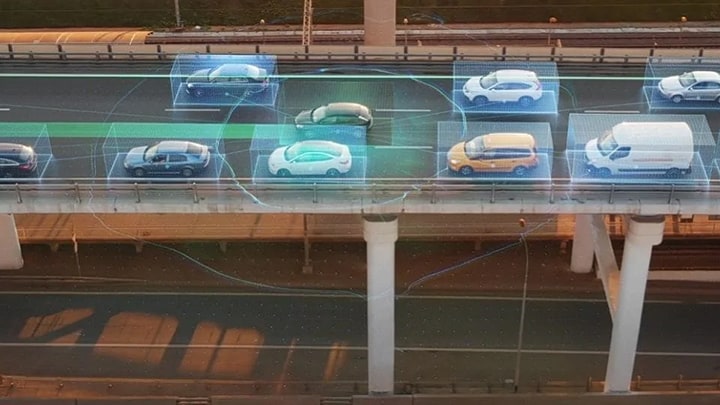Today’s cars are loaded with electronics. You’ll find dozens of
electronic control modules in a base model and even more in a luxury one.
Electronics power the touch screens on the console for seamless communication
between the car and the world outside. Surround view cameras and radar sensors
cooperate with the braking systems to keep us safe on the roads. Some cars can
even park themselves.

Hundreds of millions of lines of code are required to make these cars run.
It’s so much code, in fact, that it surpasses the amount found in a
passenger airplane. And this is just the beginning. Increasing connectivity,
autonomy and electrification means more code and more demands on the
processors.
Carmakers need to systems integration
It’s common for cars to contain features that use a dedicated processor
and unique software. For example, the electronics and software typically used
to control braking systems are very different from those used to control
powertrain systems. However, the low amount of re-use of both hardware and
software is a problem for automakers. It means slower, costlier development
and a later delivery date to dealer showrooms.
Coding efficiencies diminish since each component is designed disparately from
other systems in the car. Often the software is incompatible with other
connection points inside the vehicle, requiring even more code to facilitate
the exchange of information. Look at dynamic stability control, for example.
It requires instantaneous communication between the braking and powertrain
systems to ensure the right balance of braking and power is applied to the
vehicle. Because each of the systems run unique software, an extra layer of
software might be required to get the two to connect and “talk”
to one another.
To run the code reliably, high performance computing is required. Inside
advanced driver assistance (ADAS) and self-driving systems, for example, the
processor needs to crunch enormous amounts of data generated by sensors such
as radar, lidar and vision systems. Using this data, the processor can
determine the location of obstacles, predict their motion, plan the trajectory
the vehicle must take and even control the vehicle along that path. The
processor continuously updates the optimal path in real time to account for
the ever-changing behavior of real road users. The processor needs to connect
and communicate to the steering, braking, clusters and sensors around the car
– securely and safely without fail.
Further fueling the pressure for automakers is the opportunity to enhance the
in-vehicle experience and deliver cars that meet emerging new business models.
Similar to a smartphone, cars should offer connected, upgradable and
personalized experiences. And, like the smartphone, it should have the ability
to add new features and subscribe to new services.
All of this adds to up to incredibly opportunity – and extreme
complexity – for automakers who are forced to leader systems
integration of hardware, software, security and safety. And they’re
under tremendous pressure to speed up the roll out of the latest features to
consumers. A standardized way of working across vehicle application domains
– and even market segments and geographic regions — is needed to
meet increasing performance demands and control over skyrocketing development
costs.
Reinvented car hardware that supports growing complexity
At NXP, we realized we had to reinvent the hardware to support the software of
future vehicles.
Our recently announced S32 Automotive Processing Platform
was built on a scalable, common hardware architecture that uses a common
hardware security engine. The S32 offers 10 times the performance of
today’s top safety performing platform. It also provides an identical
software development environment across all of our automotive processors. This
means that carmakers can use the same base code across hundreds of
applications, from seat reclining to autonomous driving.

With up to 90% of code re-use, carmakers save valuable hours of development
time so they can roll out new cars to market faster.
Even more industry-changing is that carmakers have the ability to deliver new
products and features long after the car rolls out of the dealer lot and into
the hands of consumers with S32 secure over-the-air (OTA) updates. Automakers
can offer option packages that change throughout the life of the car to match
consumer preferences, and even introduce new features and new systems. The S32
OTA provides zero downtime plus full roll-back features on applications that
are running on S32 processors.
Here’s how the NXP S32 architecture changes car development
-
Scalability across the S32 product family: From small
low power ARM® Cortex®-M, Real Time optimized Cortex-R and highest
performance Cortex-A class performance classes, with ASIL D capability at
each performance level
-
Secure over-the-air updates: Zero downtime OTA
capability with full roll back options to any S32 enabled car domains via a
secure gateway and common domain architecture
-
Security: The best of NXP’s core security
concepts across new SoCs launched in the S32 family, offering scalable
solutions that are the benchmark for the automotive industry
-
Consistent development environment: The S32 SDK allows
development efforts to be shared across domains and eliminates duplication
of multiple software modules and application-specific peripherals and
accelerators on each microcontroller gives tailored hardware support for key
domain requirements like secure gateway, radar, vision, powertrain,
braking and motor control
-
Artificial intelligence: The S32 platform will support
a range of AI accelerators targeting ADAS applications that will accelerate
algorithms to support functions, such as object detection and classification
in the areas of vision, radar and sensor fusion
Today’s new cars include many safety, personalized and connected
features. Software will only continue to grow in importance as we move closer
to autonomous driving. That’s why a common platform of hardware and
software is critical to meet the growing complexity that we’re seeing
today.
Resources and related links:
About the S32 Automotive Platform






